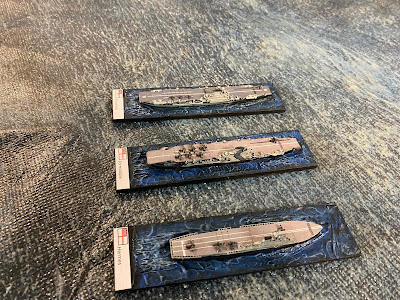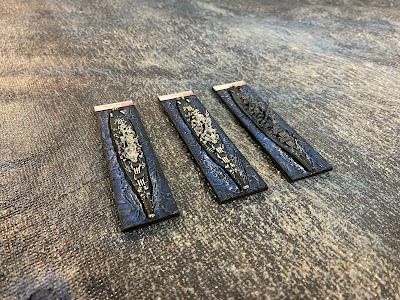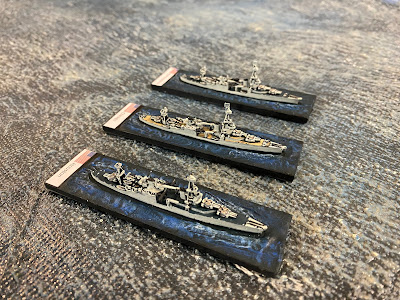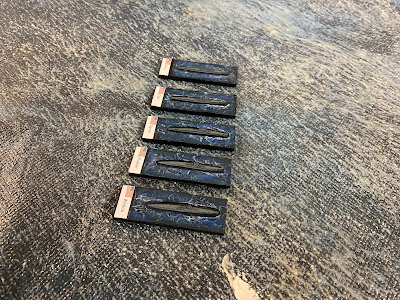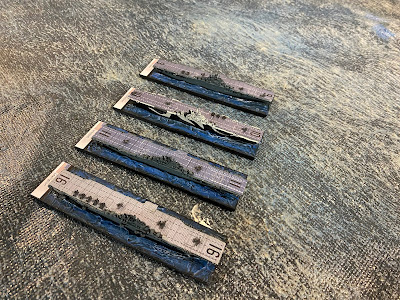Following on from my earlier promise not to drag out too many posting for this project lest I turn this into a naval wargaming blog, here are the recently-completed sixty-nine ships comprising my US Navy fleet.
First off, three Iowa class battleships in the Iowa, Missouri and New Jersey. I have always thought this is one of the most beautifully designed classes of battleships and they are the most expensive under the Nimitz rule system at 48 points each, compared to the Yamato's 45 points and an average of around 35 points for most other battleships. It was a particularly memorable experience to be able to spend an hour or so fossicking through the Missouri in Pearl Harbour a few years ago:
The South Dakota, seen here with her sisters Indiana and Alabama, are to my eye also beautifully designed and pack quite a punch:
Next up the North Carolina and Washington alongside the USS Texas:
The US Navy camouflage system was quite easy to follow and again I purchased some "authentic" US Navy colour sets from Lifecolor. Decks were painted blue throughout most of the war, and Measure 22 complemented with a Navy blue hull makes for some quite dark colour schemes. Where I was forced to used this I used another earlier war US Navy colour called Ocean Blue, just to lighten things up a little as on the Pennsylvania below, seen here alongside the Mississippi, Colorado and Nevada:
I completed six Baltimore class heavy cruisers including the Baltimore, Boston, Quincy, Canberra, Pittsburgh and Saint Paul. The Canberra was actually named in honour of the Australian County class cruiser which had been lost operating alongside the US Navy in 1942 and was the first US warship named after a non-US capital city. The second USS Canberra was commissioned a couple of weeks ago in Sydney which is the first time a commissioning ceremony for a US Navy warship has been held outside the US:
Below are two New Orleans class heavy cruisers in the San Francisco and Tuscaloosa, alongside the one-of-a-kind Wichita:
The Northampton, Chicago and Houston:
and the Portland and Indianapolis, alongside the light cruiser Detroit. The Indianapolis is famous for delivering the components for the atomic bomb that was to be dropped on Hiroshima, and was sunk by a Japanese submarine four days later. The 600 survivors had a terrible time and it is estimated that between 40 to 150 were taken by sharks:
The four Brooklyn class light cruisers here are Brooklyn, Philadelphia, Honolulu and Helena:
With three Cleveland class cruisers in Cleveland,
Miami and Colombia:
And three Atlanta class light cruisers in Atlanta,
Juneau and San Diego:
I completed fifteen destroyers in total, with six Fletcher class destroyers; the Fletcher, Radford,
Jenkins, Ross, Laws and Pritchett:
Three Benson class destroyers with the Benson, Madison and Laffey, and three Porter Class with the Porter, Phelps and Moffett:
And finally three Bagley class destroyers with the Bagley, Blue and Henley:
While I was looking up the colours for the Porter Class destroyers I stumbled across the story of the USS William D. Porter, a Fletcher class destroyer and what became known as the "unluckiest ship in the Navy". Unlucky is probably being a little generous as its voyage to escort the Iowa on its mission, in strict secrecy and radio silence, to transport Roosevelt to the Tehran conference began with the William D. Porter flailing an anchor which destroyed the lifeboat mountings and railings of a ship moored alongside.
Joining the taskforce the following day, the William D. unfortunately let loose a depth charge which exploded, causing the Iowa and all the other escorts to scatter in the belief they were under U-boat attack. In one report I read the Captain of the destroyer messaged the Iowa to explain what had happened and was subsequently chastised for breaking radio silence. Either way, the following day the task group decided to demonstrate their anti-aircraft drill to Roosevelt, to be followed up by a mock torpedo attack on the Iowa. While three out of the four torpedoes launched by the William D. Porter were the correct dummy torpedoes, the fourth was a live torpedo. Unsure now what to do with a live torpedo heading toward the Iowa with the US President on board, but also cognisant of not breaking radio silence again, the ship decided to signal the Iowa using a signal lamp but unfortunately sent the wrong message that the destroyer was about to reverse rather than it had launched a live torpedo. Luckily the torpedo detonated harmlessly behind the Iowa and Roosevelt must have seen the funny side as he apparently subsequently commuted the sentence of the sailor responsible, there being no other charges laid.
Next up are five Gato class submarines, the Gato, Cod,
Darter, Flasher and Wahoo. There was no way I could resist including a submarine named Wahoo:
One of the most difficult things at times to follow was the US Navy's doctrine of renaming ships that were under construction for those that were lost. On reflection this is quite a clever tactic as it not only helped raise additional funding at home but must also have completely demoralised the Japanese when they thought they had sunk a ship, only to see its namesake re-emerge but with bigger and better capability. I know it demoralised me a little when I realised I had initially purchased the incorrect transfers from Flight Deck Decals for the Yorktown, seen here below in its Essex class reincarnation alongside the Essex herself, the Intrepid and the second of the carriers named Lexington.
The Hornet is another where I ended up with some spare decals, the below being the original Yorktown class carrier with a sister carrier Enterprise, alongside Ranger and Independence:
Finally, two fleet oilers Neosho and Sabine:
In the end the Japanese were overwhelmed not only by sheer numbers, but also the quality of what was being produced. There is no doubt that the US lost many lives at sea, and ships sunk are not always indicative of the lives that are lost to others that came under severe attack and managed to remain afloat, but I was genuinely surprised at how few ships above light cruiser the US Navy actually lost considering how heavily engaged they were throughout the Pacific. To my mind this just serves to underline how balanced the US Naval forces were and how severely the Japanese underestimated the industrial capacity of the United States.
Here is the bulk of the collection in its A3 storage box, with the carriers, fleet oilers and four of the battleships stored elswehere:
Next up, the last of the Royal Navy ships, and then the last two fleets in my Italian and French contingents.















